#kanze noh school
Text
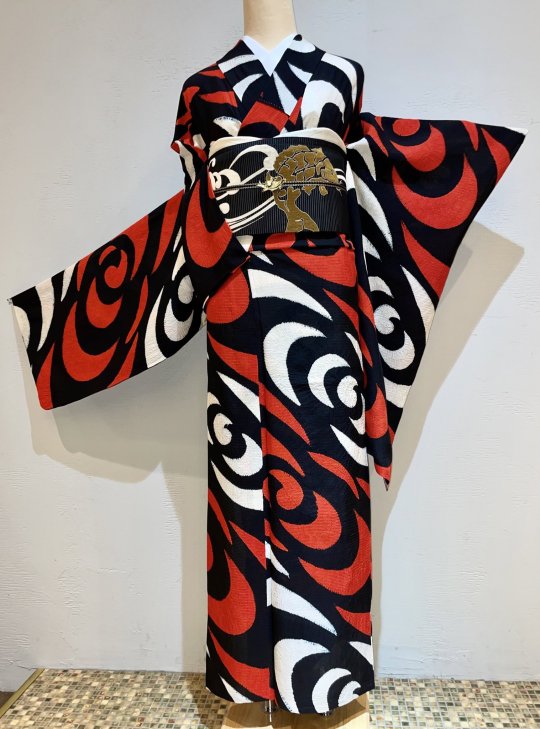


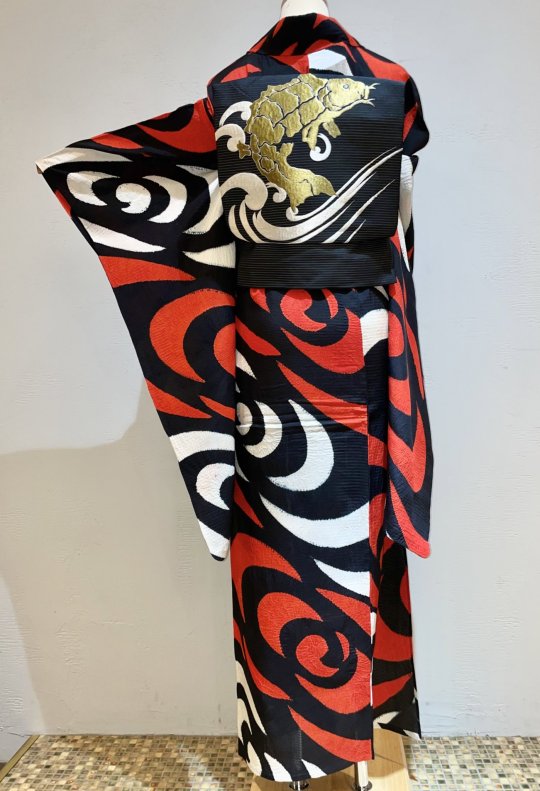
Striking antique summer weave outfit, pairing bold kanzemizu (water swirls) kimono, with a golden araiso (wave-beaten shore with jumping carps) obi
#japan#fashion#kimono#obi#summer in japan#kanzemizu#kanze noh school#swirling water#whirlpool#araiso#jumping carp#koi#koi carp#着物#帯
364 notes
·
View notes
Text
ASAGI livestreams from prestigious Kanze Noh Theater, 'Epidemic Extinction Prayer ''Amabie"'
On October 9, ASAGI from D will hold an audienceless livestream entitled Epidemic Extinction Prayer ”Amabie” from the Kanze Noh Theater. This theater that was founded in the 14th century, is not only a stage for the classic art form but also functions as the largest school for noh theater. “Noh theater” is a traditional Japanese…
ASAGI livestreams from prestigious Kanze Noh Theater, ‘Epidemic Extinction Prayer ”Amabie”‘
5 notes
·
View notes
Photo
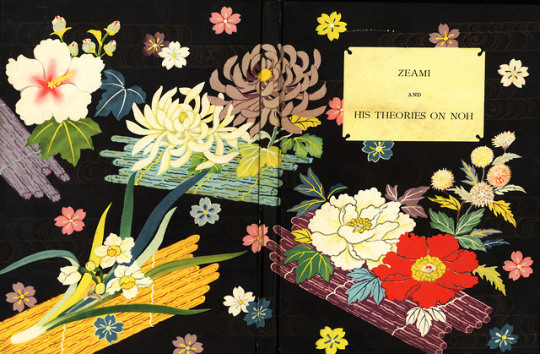
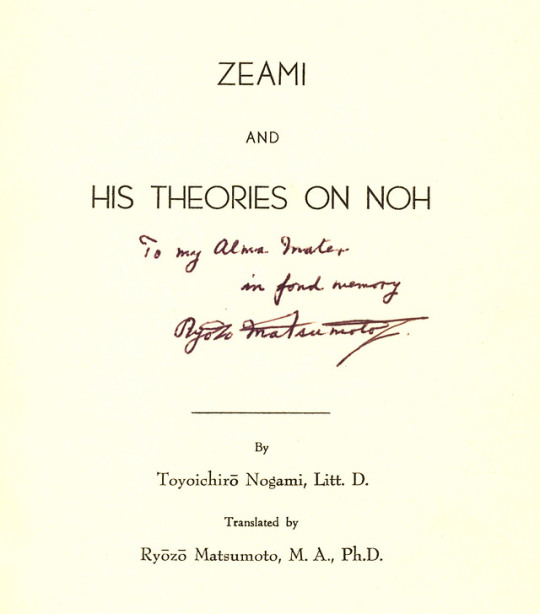

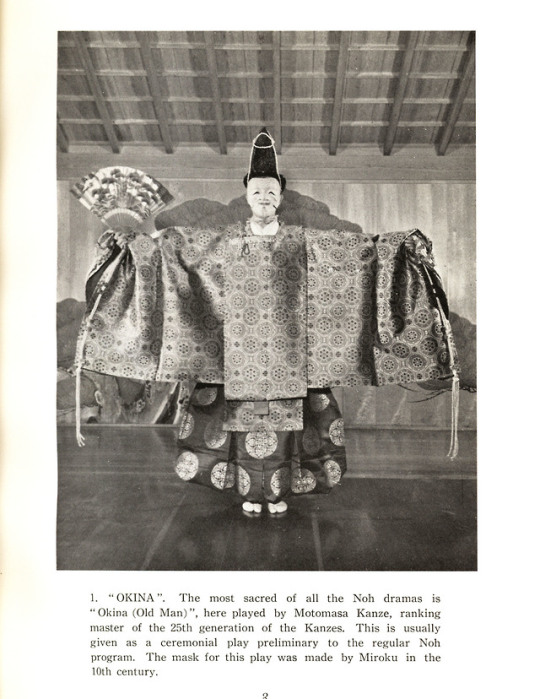



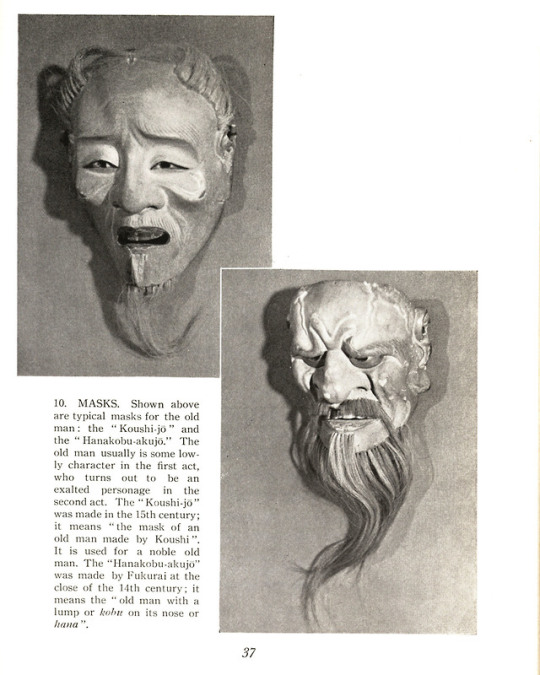


Staff Pick of the Week
This week’s staff pick is Zeami and His Theories on Noh by Toyoichirō Nogami and translated by Ryōzō Matsumoto. It was published by Tsunetaro Hinoki in Tokyo in 1955. Noh is a form of classical Japanese stage art that originates from the Muromachi period (1336-1573). The word “Noh” means “to be able,” it signifies “talent” or “an exhibition of talent.” Zeami Motokiyo was a skilled actor and playwright who was born in 1363 and died in 1443. The author Toyoichirō considered Zeami the greatest of all the Noh artists.
I chose this book as my staff pick because I was drawn to the beautiful cover and colorful woodcuts. The two colored illustrations were originally drawn by Matsuno Sōfū and were made into woodcuts by publisher Unsodo. All the plates of the masks have been produced by Hisomu Mase from the originals treasured in the Kanze family. All the pictures of the stage performance were taken by Yoshi-hiko, expert photographer of the Kanze school.
The translator Ryōzō Matsumoto wrote about the author in a preface to the book:
“Dr. Toyoichirō Nogami was born on September 14, 1883; graduated from the Department of Literature, Imperial Univeristy of Tokyo in July 1908; made professor of English literature at Hosei University in Tokyo in 1920; and became President of the same institution in 1947. He received the degree of Doctor of Literature in 1938 and died on February 23, 1950.
He is one of the greatest scholars of Noh Japan has ever produced, especially noted for his systematization of Noh dramas into an organized form.
Yaeko Nogami, author’s widowed wife, says in her preface to the Japanese Noh Plays and How to See Them by her deceased husband: “It is hardly necessary to mention that Noh is one of the major stage arts Japan is proud of. But it is to be admitted that this precious heritage remained for many years an exclusive entertainment or pastime of the aristocracy and the leisured class. It was indeed Toyoichirō who took up the Noh as an object of study to clarify its universal nature. Versed in English literature, he approached Noh with the Western methodology. Analyzing it into the ‘why’ and the ‘how’ of the art, and organizing it into a systematized form of presentation, he finally succeeded in establishing the aesthetics of Noh.”
Our copy of Zeami and His Theories on Noh includes a signed presentation inscription from the translator Ryōzō Matsumoto.
–Sarah, Special Collections Graduate Intern
#Staff Pick of the Week#Zeami and His Theories on Noh#Toyoichirō Nogami#Ryōzō Matsumoto#Tsunetaro Hinoki#Nogami Toyoichirō#Noh#stage art#plays#Zeami Motokiyo#Japan#Japanese art#Matsuno Sōfū#Unsodo#woodcut#Hisomu Mase#Yoshi-hiko#Yaeko Nogami#Sarah Finn#sarah
74 notes
·
View notes
Photo
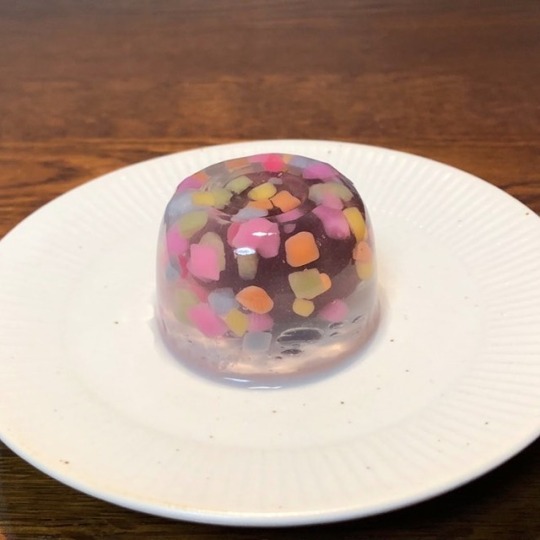
★ Jul. 21, 2018
Suetomi, Kyoto: mizu-hanabi (lit. water-firework)
——–
The combination of ‘kingyoku(-kan)’, colorful 'konashi’ pieces and an 'an (sweet bean paste)’ ball. Possibly with a traditional 'circular-ripple’ pattern called 'Kanze-mizu’* on top.
This cake might depict a (big) firework reflected on the water surface.
——–
* The pattern is associated with the Kanze school of Noh theater.
——–
#wagashi #japanesesweets #sweets #tea #teaceremony #chanoyu #japanesetea #foodie #dessert #food #matcha #fireworks #japan #japanese #kyoto #京都 #花火 #スイーツ #お菓子 #和菓子 #抹茶 #お茶 #茶道 #末富 #水花火
#wagashi#japanesesweets#sweets#tea#teaceremony#chanoyu#instafood#instasweets#foodie#dessert#foodpics#matcha#fireworks#japan#japanese#kyoto#京都#花火#スイーツ#お菓子#和菓子#抹茶#お茶#茶道#末富#水花火
88 notes
·
View notes
Text
TOKYO HOTELING INDUSTRY IS READY TO WELCOME OLYMPIC 2020
For the 2020 Summer Olympics, Tokyo joins the best group of cities that played host to the Games multiple times. IOCC’s selection of Japan’s capital further highlights it as one of the world’s most dynamic cities.
Olympic Fanatics can book Olympic Hospitality Tickets Online from our most economical online ticketing market place.
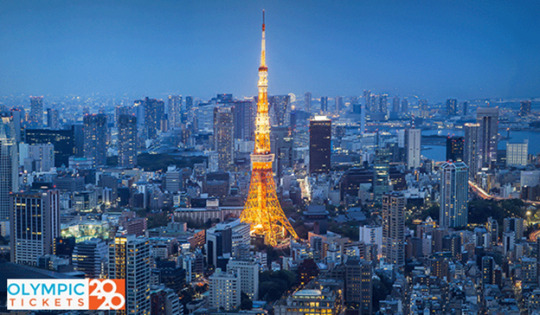
Tokyo made a big splash during the 1964 Summer Olympics, sealing its global reputation as the city of the future. The 2020 planners and policymakers, therefore, knew they had an enormous challenge in finding fresh ways to reintroduce Tokyo to the world. Numerous tech bells and whistles brought forth by Fortune 500 sponsors will enhance how spectators experience the games. Panasonic’s contributions, for example, include a translation device handling up to 10 spoken languages and a smartphone app enabling foreign visitors to instantly scan and translate signs. There’s also a big buzz surrounding driverless Lexus and Toyota taxis.
On the other hand, Tokyo follows South Korea’s performance on the world stage with the 2018 PyeongChang Winter Olympics and precedes Beijing’s next outing as a repeat Olympic city in 2022. Perhaps for these reasons, the city, and various developers are emphasizing historic preservation even as projects to improve infrastructure and accessibility apply a city-of-the-future mindset. According to the Japan National Tourism Organization, this Olympian undertaking exemplifies Prime Minister Shinzo Abe’s goal to increase the annual number of incoming foreign tourists to 40 million by 2020 and 60 million by 2030.
The reworking of the concrete-based National Stadium, used for the 1964 Olympics’ opening and closing ceremonies, embodies this approach. The old structure enters the 21st century with the implementation of a nature-focused design by noted Japanese architect Kengo Kuma, employing Japanese lumber. It serves as an anchor point of a Heritage Zone surrounding the Imperial Palace that includes upgraded and updated venues from the earlier games. The 10 new facilities, meanwhile, go up in the Tokyo Bay Zone on the reclaimed land of Odaiba, including the swimming competitions venue.
The New Shinagawa Station, launching 2020, is one of the crown jewels of the city’s infrastructure improvements. According to The Japan Times, the first major addition to the Yamanote train loop since 1971 is intended to not only improve crowd flow but also make exploring Tokyo and Japan more user-friendly years beyond the games. It dovetails into transforming the Shinagawa neighborhood and will provide a quick connection to Metro Sengakuji Station and access to Narita and Haneda airports by 2027.
Some of the most visible developments will reside in Shibuya, which adjoins Yoyogi Park, site of the new Olympic Stadium. The mega makeover includes more than 786,000 square feet of new office space around Shibuya Station and nearly 2.8 million square feet of space throughout the district. One of the most important revitalizations is Shibuya Station, adding new elevators and escalators to link the different levels and passageways, facilitating smoother transfers between commuter lines.
Other multipurpose structures in Shibuya will alter one of the world’s most photographed neighborhoods. The 750-foot-tall Shibuya Scramble Square, opening 2019, encompasses expansive rooftop space and one of Japan’s largest observation decks. Panoramic views include the iconic intersection as well as the Meiji Shrine, the Shinjuku skyline to the north, the Roppongi district to the east and (on clear days) Mount Fuji to the west. Shibuya Stream, arriving in 2018, fuses nature with practicality with 20 open-concept office floors, a fourth-floor atrium with compact workstations, and a fifth-floor lobby with an arched ceiling reminiscent of the wave-shaped patterns of the former roof of the Tōyoko Line’s terminal. Its 6,500-foot, tree-lined walkway will about the banks of the newly exposed, free-flowing Shibuya River.

Olympic Hospitality Tickets.
Developments in Ginza involve the use of repurposed buildings and designs paying homage to past architectural styles defining Tokyo retail. Early players include Ginza Place (opened fall 2016), inspired by the 1932 landmark Neo Renaissance-style Wako department store building directly across the street; and Ginza Six (G6), debuted in spring 2017 at the location of the former Matsuzakaya department store. G6’s third basement floor serves as the new home of the Kanze School of Noh, a musical theater group tracing its history back nearly 700 years. The project transplanted its historic stage, plank by plank, to pair with state-of-the-art sound and lighting, improved handicapped access and a multilingual interpretation system.
Between 2018 and 2020, the former Sony building will transform into Ginza Sony Park, where visitors will enjoy the multisensory kind experiences delivered by technological gadgets and machines devised by Sony and others. Another global Japanese brand expanding beyond retail is MUJI, Japan’s minimalist lifestyle and apparel store. When the MUJI Hotel in Ginza opens in spring 2019, visitors can draw inspiration from the brand’s unique design element in the hotel on the top four floors, as well as it's expansive home retail concept covering the bottom six and three basement floors.
Quirky boutique hotels opening or soon to open include the Wired Hotel Asakusa in the historic Taito ward; the 15-guestroom Trunk Hotel in Shibuya, distinguished by expanses of recycled woods, tiered balconies, aromatic herb gardens and organic made-in-Japan bathroom toiletries; and the Tokyo Skytree, designed by Tokyo Olympic stadium architect Kengo Kuma, integrating industrial materials with natural wood.
Olympic enthusiasts can get up to the minute updates of Olympic Tickets through our most trusted online ticketing market place. OlympicTickets2020.com is the most reliable source to book Olympics 2020 Tickets.
0 notes
Text
Experiencing the World of Japanese Noh Theater at the Hallie Flanagan Studio Theatre
Experiencing the World of Japanese Noh Theater at the Hallie Flanagan Studio Theatre
“Experiencing the World of Japanese Noh Theater—Featuring Hisa Uzawa and Hikaru Uzawa”
One of the first women to act as a lead performer in a traditional Noh lineage, Hisa Uzawa is a prominent member of the Tessenkai branch of the Kanze School of Noh theater in Tokyo. She has been designated as a “Living Cultural Treasure” by the Japanese government. She and her daughter Hikaru, also an…
View On WordPress
#Experiencing the World of Japanese Noh Theater#Hagoromo#Hallie Flanagan Studio Theatre#Hikaru Uzawa#Hisa Uzawa#Japanese Noh Theater#Kanze School of Noh theater#Noh Theater#Northampton MA#Smith College#Tessenkai#Tessenkai branch of the Kanze School of Noh theater
0 notes
Link
700-year-old Kanze school, Blood-C creative team, leading VR researchers collaborate
0 notes
Text
Kanze Nohgaku Theater moves back to Ginza
#nohgaku [The Japan Times]The Kanze Nohgaku Theater in Tokyo’s Shibuya district plans to close in March and reopen in Ginza in November 2016, according to the head of the country’s largest school of noh. The new theater will ...
0 notes
Text
Kanze Nohgaku Theater moves back to Ginza
#nohgaku [The Japan Times]The Kanze Nohgaku Theater in Tokyo’s Shibuya district plans to close in March and reopen in Ginza in November 2016, according to the head of the country’s largest school of noh. The new theater will …
0 notes
Text
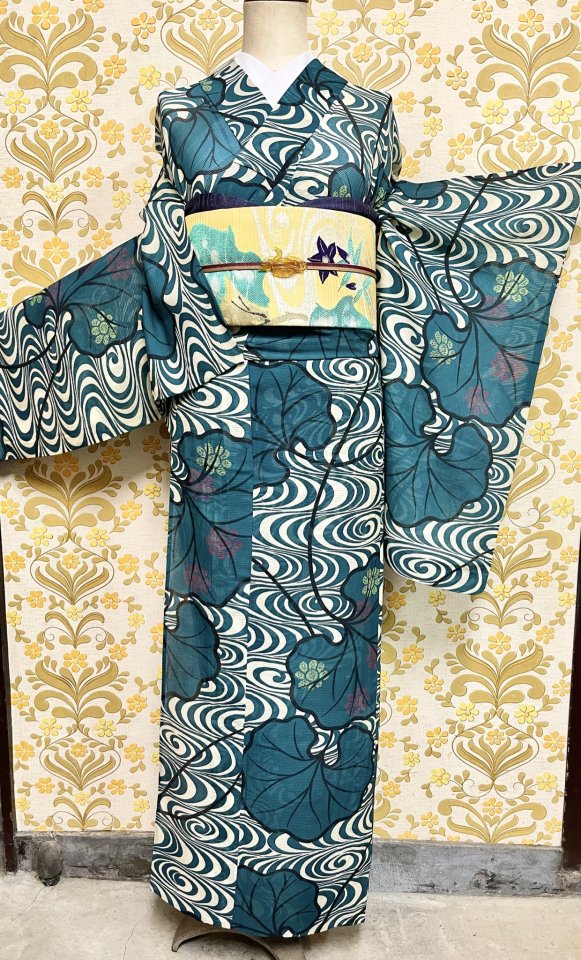


Fantastic greens for this tsuwabuki (leopard plant, Japanese silverleaf) themed summer outfit.
The kimono has a kanzemizu (swirling water pattern, originated from Kanze school of Noh) ground, while the obi also presents kikyo (Chinese bellflower) over ryuusui (running water/stream).
#japan#fashion#kimono#obi#summer in japan#tsuwabuki#leopard plant#japanese silverleaf#kanze mizu#ryuusui#swriling water#running water#stream#kikyo#chinese bellflower#着物#帯
543 notes
·
View notes
Photo

★ Nov. 24, 2017
Kameya-yoshinaga, Kyoto: oru-nishiki (lit. weave/woven-brocade)
——–
‘Joyo’-type Japanese cake with a filling of strained-type sweet bean paste 'koshi-an’ and possibly with a traditional 'circular-ripple’ pattern called 'Kanze-mizu’* on top. The cake might depicts a maple leaf falling on water and creating widening rings.
—-
The phrase 'oru-nishiki’ appears in a well-known Japanese children’s song 'momiji (maple leaves in autumn colors)’, which is a paean to the beauty of the leaves. The part including the phrase can be interpreted as “the fallen maple leaves create a 'beautiful woven brocade fabric’ (= beauty) on water”.
——–
* The pattern is associated with the Kanze school of Noh theater.
——–
#wagashi #japanesesweets #sweets #tea #teaceremony #chanoyu #instafood #instasweets #foodie #dessert #foodpics #sweettooth #japan #japanese #kyoto #京都 #秋 #紅葉 #スイーツ #和スイーツ #お菓子 #和菓子 #お茶 #茶道 #亀屋良長 #織るにしき
#instafood#和菓子#スイーツ#wagashi#和スイーツ#sweettooth#紅葉#japanese#foodpics#japan#お茶#dessert#秋#instasweets#sweets#tea#京都#茶道#kyoto#chanoyu#japanesesweets#亀屋良長#teaceremony#織るにしき#お菓子#foodie
71 notes
·
View notes
Photo

★ Jul. 8, 2017
Oimatsu, Kyoto: mizu-no-aya (lit. color/splendor of water?)
——–
Jelly-like, translucent ‘kingyoku(-kan)’ with a traditional 'circular-ripple’ pattern called 'Kanze-mizu’ on top. The pattern is associated with the Kanze school of Noh theatre.
——–
#wagashi #japanesesweets #sweets #teaceremony #tea #chanoyu #sadou #chadou #japan #japanese #kyoto #京都 #スイーツ #和スイーツ #菓子 #お菓子 #和菓子 #お茶 #茶道 #老松 #水の彩
#japan#chadou#和菓子#京都#和スイーツ#kyoto#teaceremony#japanesesweets#菓子#老松#茶道#sadou#japanese#お茶#お菓子#sweets#instafood#スイーツ#chanoyu#wagashi#instasweets#水の彩#tea
77 notes
·
View notes
Text
Kanze Nohgaku Theater moves back to Ginza
#nohgaku [The Japan Times]The Kanze Nohgaku Theater in Tokyo’s Shibuya district plans to close in March and reopen in Ginza in November 2016, according to the head of the country’s largest school of noh. The new theater will ...
0 notes
Text
Kanze Nohgaku Theater moves back to Ginza
#nohgaku [The Japan Times]The Kanze Nohgaku Theater in Tokyo’s Shibuya district plans to close in March and reopen in Ginza in November 2016, according to the head of the country’s largest school of noh. The new theater will …
0 notes
Text
Kanze Nohgaku Theater moves back to Ginza
#nohgaku [The Japan Times]The Kanze Nohgaku Theater in Tokyo’s Shibuya district plans to close in March and reopen in Ginza in November 2016, according to the head of the country’s largest school of noh. The new theater will ...
0 notes
Text
Kanze Nohgaku Theater moves back to Ginza
#nohgaku [The Japan Times]The Kanze Nohgaku Theater in Tokyo’s Shibuya district plans to close in March and reopen in Ginza in November 2016, according to the head of the country’s largest school of noh. The new theater will …
0 notes